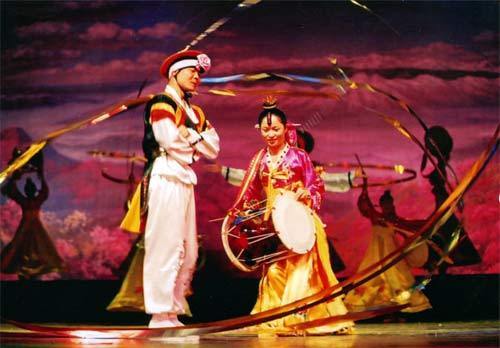
The Farmer's Dance is a representative dance favored by the Korean ethnic group in northeastern China, and is especially popular in the Korean congregating area of Jilin, Heilongjiang andLiaoning provinces.
It is characterized by "beating tambourines" and "swingingelephant caps". The movements of the tambourine beaters are varied and vigorous, posing like horse riders and archers; while the elephant cap swingers use their necks as axles just to swing the 12-metre long tape tied to the cap, which move like wheels round the dancers and dazzles the viewers.
There are usually about 60 dancers, wearing white costumes with colorful vests and sashes. Some hold a banner with the characters reading "Agriculture is the basis of society", which shows that the aim of this particular dance is as much about paying homage to agriculture as it is entertaining the farmers. Others sing and dance to the sounds of various percussion instruments that include small and large gongs, double-headed hourglass and basic barrel drums, and sometimes, conical flutes. It is the player of the small gong who sets the beat and leads the dance.
The music is performed by a small band featuring a small gong, which sets the rhythm, a large gong, a round barrel drum, a large hourglass drum, and often an oboe-like instrument which provides a melody. The musicians dance as they play, and other dancers beat time to the music with small hand-held drums. The spinning hat dance is one of the most exciting to watch and perform. Some members of the farmer's music band wear black hats with longpaperstreamers attached to the top. These dancers spin in circles, beating a small gong or drum as they fly through the air.
Although different Korean areas have their own variations of the Farmer's Dance, two major styles stand out: one is from the eastern and southeastern area and the other is from the southwestern region. The former is characterized by its fast-paced music and the acrobatic movements of the dancers, with the most exciting feature being the dancers who twirl long, white paper streamers attached to their hats to the music. The latter style of the dance is slower and less acrobatic. In place of twirling hats with streamers, the dancers wear conical hats topped with big, colorful paper flowers. As the dancers move, these flowers bob and turn with every movement of their heads.
The Korean farmer's dance originated in ancient times when Koreans began to farm and hold rituals to pray for good harvests and good weather. It was traditionally performed during planting, harvesting and other agricultural events, to help them overcome their fatigue and anguish. Early records mention Korean farmers working to the beat of percussion instruments.
Until recently, it was performed in rural areas, in particular during planting and harvesting, to give encouragement to farmers and to provide them with a beat to work to. It was also often performed as a part of shamanistic rituals to protect houses from thieves and fire, to purify the village, and to give thanks to the river or mountain spirits.
Today the dance is seen mostly at special festivals and folk art competitions but can also be observed from time to time on village holidays and at major village events in rural areas. When it is performed now, the two major styles of the dance are often combined.
In 2009, Farmers’dance of China’s Korean ethnic group was inscribed on the Representative List of the Intangible Cultural Heritage of Humanity by the UNESCO.
